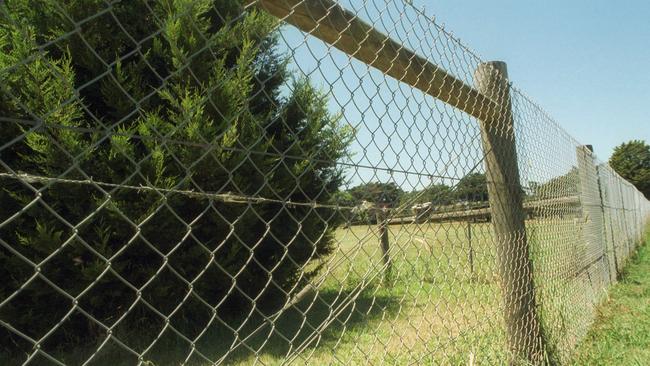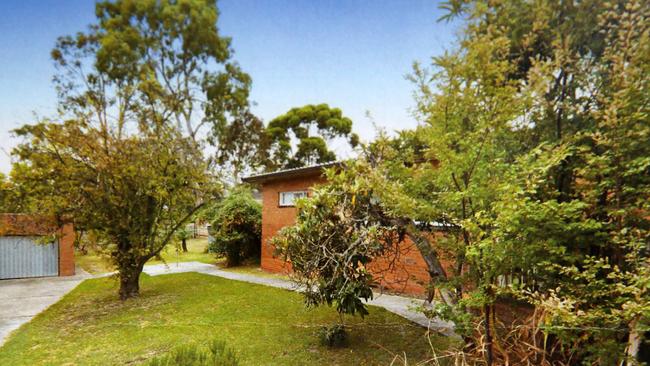New data shows most Melbourne neighbour blues are over fences and trees: Here’s where you stand
If a neighbour’s tree shades your yard or blocks your view, what can you do? And what about limbs overhanging your property or roots creeping under the fence? Here are your rights.

News
Don't miss out on the headlines from News. Followed categories will be added to My News.
Victorian neighbours fight most about fences and trees.
Of the scores of neighbourhood blues that came before the Dispute Settlement Centre of Victoria between January and March this year, a whopping 631 of them were about fences.
The next most common dispute brought to the centre to be settled involved trees, with 263 matters dealt with over the same time frame.
A person’s behaviour accounted for 171 matters, property disputes for 136, owners corporation issues for 134, problems between cotenants for 76 and noise for a surprisingly few 59.
To lessen the burden on the Dispute Settlement Centre, here’s their advice on the law as it relates to fences and trees.
Fence law in Victoria: Your rights, obligations
Dividing fences are joint property, separating two pieces of land and usually running along the common boundary between the two properties.
Both neighbours have the same rights and obligations when it comes to building or repairing a dividing fence, even if it’s not located on the common boundary.
Fencing costs are shared equally between neighbours. But this depends on whether the current fence needs to be repaired or replaced, one neighbour wants a different or more expensive fence, or if one neighbour has deliberately or negligently damaged the fence – where they must pay for the repairs.

You may also need to share the cost of more than just the fence itself. This can include things like clearing the land so a fence can be built or repaired, removing the existing fence, having the land surveyed to find the common boundary and using temporary barriers.
You must pay for a “sufficient” dividing fence. The law in Victoria doesn’t say how tall a fence should be or what it should be made from. It says that neighbours should contribute equally to a “sufficient dividing fence” which depends on things including the style of the existing dividing fence, how you and your neighbours use the land, reasonable privacy and security concerns and the types of other fences used in your local area.
For residential properties, a sufficient dividing fence might be a 1.8m timber paling fence. For rural properties, a sufficient dividing fence might be a wire and post fence.
When preparing to repair, replace or build a new fence first check your council’s planning rules as different council areas may have different rules and regulations. Check your local council’s website for information about fencing in your neighbourhood.
If you or your neighbour want something different like a higher fence or one made of more expensive materials, the person who wants this pays the difference in cost between a sufficient dividing fence and the higher standard. If you both agree, you can share the extra cost.
If you and your neighbour can agree on where the rails and framing of the fence should face, then you can build as agreed. If you can’t agree, the law says if the dividing fence is between two residential properties and the rails and framing should go on the same side as the existing dividing fence.

If there’s no existing dividing fence, the rails and framing should go on the side least subject to weathering.
If you are unable to talk to a neighbour in a civil fashion about a fence, there is the option to send a Fencing Notice, which is a formal document that outlines a proposal to repair, replace, or build a new fence. Your neighbour has 30 days to respond from the day they receive the Fencing Notice. It’s a good idea to send it to them by registered post so there is proof that they have received it.
If the fence replacement or repair is due to fire, flood, or damage, and you don’t have time to issue your neighbour a Fencing Notice, you can proceed with the works without giving notice and without their agreement, however, you should at least talk to them about what you’re going to do.
If you want your neighbour to contribute, you need to give them an Urgent Fencing Notice listing the type of fencing works done, the cost, and why it was urgent. That way your neighbour has an opportunity to have a say. If they don’t agree with what you did, you will have to go to the Magistrates’ Court to get payment.
Tree laws in Victoria: Your rights, obligations
In Victoria, trees are covered by general property law and “common law”, which is law the courts have developed over time. This means that generally, a tree owner doesn’t have a legal obligation to maintain their tree unless it’s causing damage or nuisance. Trees can also be covered by council rules. Check with your council to see if the tree causing the problem is protected, but bear in mind your council won’t help resolve a dispute or cut back your tree for you unless it’s on council land.
Cutting back trees that cross your boundary line
You have the right to cut back any branches, leaves, or roots that cross your property boundary line at your own cost. This is known as the “right of abatement”.
If you rent your home, contact your property manager if you have an issue with a neighbour’s tree. Acting without permission from your rental provider could be a breach of your rental agreement.
Before you cut back your neighbour’s tree you should talk to your neighbour about the maintenance you want to do and ask your local council if the tree is protected, as you may need a permit to cut it back.
Get advice on how to cut back branches without harming the tree or shrub.
Discuss and reach agreement with your neighbour on how you will return their cuttings.
Remember that you’re liable for any damage you cause to your neighbour’s tree and you need your neighbour’s consent before entering their land to perform maintenance.

Trees that block out light or views
In Victoria, there are no rules or regulations that can force a property owner not to plant big trees. This is something for neighbours to negotiate and agree on themselves.
If you can’t reach an agreement with your neighbour about managing a tree that blocks light or views, mediation might be a good idea. Mediation gives you and your neighbour an opportunity to speak with each other and come to an agreement about the maintenance of the tree. If mediation isn’t an option or your neighbour does not want to mediate, you can consider going to court but seek independent legal advice first.
If a tree located on a nature strip or in a parkland, is overhanging or causing damage to your property, call your local council to check if the tree is protected. If it is protected, the council may send an arborist to look at the tree and decide on what to do next.
If the tree isn’t protected, you may cut back the parts of the tree that overhang your boundary line.
Paying for maintenance and damage caused by trees
Tree owners are not obliged to pay for tree maintenance but may decide to do so to reduce risk of damage to someone else’s property.
You can maintain branches that cross your boundary line but you need to do this at your own cost.
If you want your neighbour to pay for any tree maintenance, you’ll need to show it’s damaging your property or it’s found to be causing a ‘private nuisance’ at court.
Damage caused by overhanging branches, foliage and roots
If your neighbour’s tree has damaged your property, it is possible that your neighbour is liable for the damage. It’s a good idea to see if the damage is covered by insurance. If not, try to negotiate an agreement with your neighbour. Going to court can be expensive and take a long time.
Gather as much information as possible so you can have an informed discussion with your neighbour. This could include an arborist’s report showing that the tree caused the damage,
photos of the damage, quotes for the costs of repairs, maintenance or removal.

Talking to your neighbour about a tree or shrub
The easiest and quickest way to solve a tree dispute is by having an informal chat with your neighbour about the problem. The best outcome would be to agree on a maintenance plan together.
If you don’t know your neighbour well, try putting a note in their letterbox first to start the conversation. Introduce yourself and ask if you can arrange a time to talk to them about your issue. In the conversation it’s important to be clear about your concerns and listen to and acknowledge your neighbour’s point of view.
Going to court
This option can be costly, stressful and time consuming but a magistrate can determine whether a tree constitutes “a private nuisance” and who contributes what to the costs.
You need to apply to court for a private nuisance claim, so get legal advice first.
A private nuisance is when your use and enjoyment of your land is affected by another person’s act or omission.
Keep in mind that trees drop leaves, bark, sticks, flowers, fruit and sap as part of their normal life cycle. This isn’t usually considered a private nuisance. The court will use common sense to inform its decision.
It’s important to recognise that living in a neighbourhood means that at times there will be competing interests or activities from people nearby. The court takes a pragmatic look at these and recognises that some noise, annoyance, inconvenience and discomfort are likely to occur wherever people live.
The Magistrate’s role is to decide on the points of law about your tree issue only. Because the magistrate may not address everything that’s important to you, you might not end up with the outcome that you want. This is why you’re much better off finding a solution with your neighbour.




